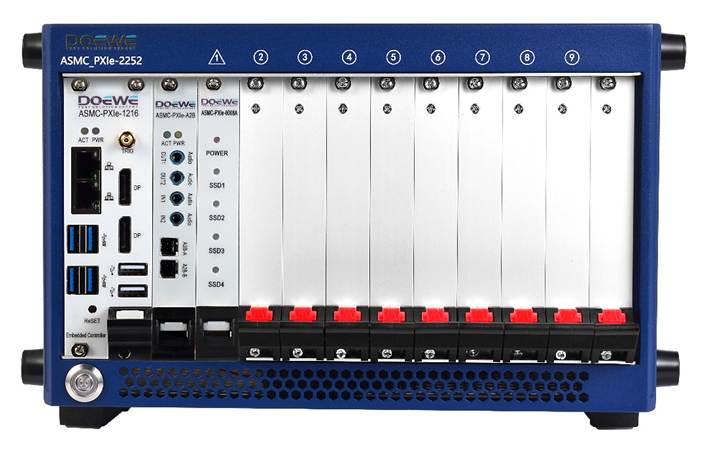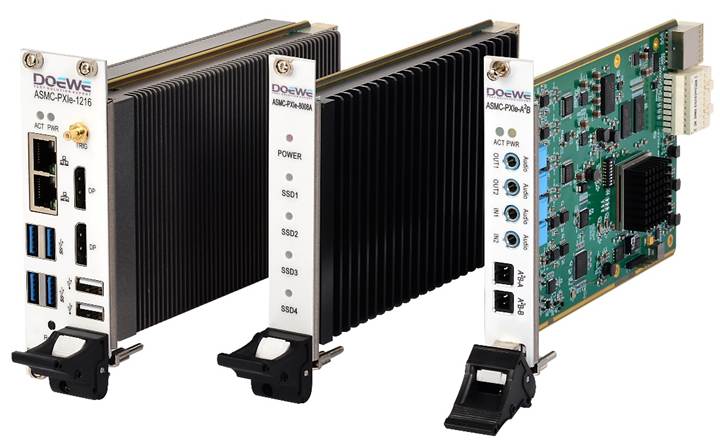From automated production lines to smart cockpits, the surge in road hazard testing and monitoring scenarios is driving unprecedented growth in the Data Acquisition (DAQ) market. Global DAQ revenue is projected to rise from $2.8 billion in 2025 to $3.7 billion by 2030, at a CAGR of 5.9%. Among diverse platforms, PXIe modular instrumentation—leveraging PCIe high-speed backplanes and nanosecond-level synchronization—is accelerating rapidly. Grand View Research indicates a 9.7% CAGR for modular instruments (2025–2030), with PXI(e) already holding a 44% market share. Verified Market Reports further predicts an 8.2% annual growth for PXI from 2026–2033. However, as sensor channels, resolution, and real-time algorithms escalate, even backplanes with 8 GB/s bandwidth approach their limits when handling high-speed vision, millimeter-wave radar, and multi-physical measurements. High-speed front-end interfaces have become the new bottleneck, while Gigabit Ethernet (GbE) emerges as the preferred solution for the "last mile" of data transmission, thanks to its universality, long-distance reach, and scalable bandwidth.
PXIe DAQ systems are modular instrument platforms built on PCIe high-speed serial buses, integrating PXI precision triggering and clock resources. Within a single chassis, the backplane delivers up to 8 GB/s (PCIe Gen3) of point-to-point bandwidth per peripheral slot while maintaining ±100 ps star triggering and a 100 MHz differential system clock, enabling simultaneous high-speed transfer and nanosecond synchronization. Compared to legacy PXI (parallel PCI, 132 MB/s) or cPCI/cPCIe, PXIe maintains backward compatibility while evolving to Gen4/Gen5 via the commercial PCIe ecosystem, doubling bandwidth and channel density every 3–4 years.
Its "chassis + controller + multi-function acquisition card + high-speed storage" Lego-style flexibility allows R&D engineers to assemble custom instruments in hours. The software-defined architecture supports one-click integration with LabVIEW, Python, and C/C++, enabling algorithm validation, production testing, and remote monitoring on shared hardware. As sensor resolution, sampling rates, and AI-driven raw data demands explode, "high-speed × synchronization" has become essential—explaining PXIe’s dominance in the modern DAQ market.

Figure 1 Front View of Doewe Technologies PXIe DAQ System
From a bus perspective,CompactPCI (cPCI) still uses 32-bit 33 MHz parallel PCI, with peak single-slot bandwidth limited to 132 MB/s. The backplane lacks dedicated trigger or clock lines, forcing multi-board synchronization to rely on software timestamps.PXI adds a 10 MHz system clock, 8-line trigger bus, and star triggering to the cPCI mechanical structure, achieving inter-slot alignment accuracy better than ±100 ps. However, bandwidth remains constrained by parallel PCI.cPCIe directly replaces the backplane bus with serial PCI Express: Gen1 ×1 Lane delivers 250 MB/s, while full-length ×16 reaches 4 GB/s. Yet, the specification still lacks hardware trigger/clock networks, making high-precision synchronous measurements challenging.PXIe integrates the strengths of both—retaining PXI's triggering and 100 MHz differential system clock (inter-slot deviation ≤100 ps, jitter <3 ps) while upgrading the backplane to PCIe Gen3 ×4, delivering up to 6 GB/s point-to-point bandwidth per slot and aggregate chassis bandwidth exceeding 24 GB/s.
Thus, the core competitiveness of PXI/PXIe lies in "high bandwidth × hardware-level synchronization": 10 MHz/100 MHz references, star triggering, and picosecond jitter ensure seamless multi-channel data alignment, while PCIe serialization empowers PXIe to concurrently handle Gigabit network streams, millimeter-wave radar, and high-resolution sensor data, establishing it as the mainstream backbone of modern high-speed DAQ systems.
A typical DAQ system uses a chassis with an embedded controller/external host to provide computing power and reference clocks, inserting various acquisition cards (voltage, temperature, network GigE, etc.) and high-speed storage cards as needed. All plug-in boards share the 10 MHz/100 MHz clock and multiple trigger lines via the backplane bus to achieve hardware-level synchronous sampling of multi-physical quantities. In the DAQ domain, "network cards" are not merely communication interfaces but a category of network-type acquisition cards. The reason is simple: industrial cameras, distributed sensors, and even entire test nodes now "package" data into Ethernet frames for direct transmission—the network card captures raw measurement data. For example: GigE Vision industrial cameras adopt Gigabit Ethernet as a universal interface, continuously outputting high-speed image streams within IP67-rated enclosures, fully compliant with GenICam/GigE Vision standards for plug-and-play integration with third-party algorithm libraries.Distributed I/O and smart sensors widely use EtherCAT or OPC UA remote modules to encapsulate quantized data (strain, voltage, temperature) into UDP/TCP frames for real-time transmission.

Figure 2 Side View of Doewe Technologies PXIe Storage Card
Unlike traditional analog/digital I/O cards, these network acquisition cards require no local ADC—data inherently exists as network frames. Their critical capabilities shift to "line-rate capture + precise timestamping." A 1 GbE link offers a theoretical bandwidth of 1 Gb/s (≈125 MB/s), sufficient to carry approximately 80 channels of 24-bit/96 kHz audio or 4 channels of uncompressed 1080p60 video streams in parallel. Backed by the PXIe backplane’s PCIe Gen3 ×4 (6 GB/s), network cards coexist smoothly with other high-speed acquisition modules without congestion. Due to their "long-distance, scalable, universal protocol" characteristics, Gigabit NICs have evolved from IT peripherals to indispensable high-speed front ends in PXIe DAQ systems.
The Doewe ASMC-PXIe-7024 Gigabit NIC positions itself as the "network front end" for PXIe DAQ systems, Compact 3U PXIe dimensions (100 mm × 160 mm, 4 HP), integrating 4× 1 GbE RJ-45 ports on the front panel with 1000/100/10BASE-T auto-negotiation.Onboard FPGA features TCP/UDP/IP checksum offloading and TCP segmentation hardware engines, maintaining <5 µs forwarding latency at line-rate capture.Zero-copy frame data push to the backplane via PCIe DMA—when paired with Doewe P2P storage cards, enables continuous Gigabit stream recording without packet loss.Beyond basic flow control and PXE remote boot, the card optionally supports SM2/SM3/SM4 national cryptographic algorithm acceleration for localization or confidential testing requirements.Fully self-developed design with independent intellectual property, compatible with Windows 7/10, Windows Server, Linux, and Galaxy Kylin/NeoKylin OS, operating stably long-term in 0°C–55°C environments.With its differentiated capabilities—"quad-port Gigabit + hardware acceleration + zero-copy direct link + domestic encryption"—the ASMC-PXIe-7024 injects long-distance, universal, and secure high-speed acquisition channels into the PXIe platform, seamlessly integrating network sensors, GigE Vision cameras, and EtherCAT nodes into the Doewe DAQ ecosystem.
Doewe Technologies anchors its complete "Acquisition + Analysis + Storage" DAQ ecosystem on the PXIe chassis: dozens of acquisition cards (voltage, current, temperature, strain bridge, CAN/LIN/FlexRay, A²B audio, 1/10 GbE) combine with the ASMC-PXIe-8016 P2P storage card (16 TB, >6 GB/s sustained write) and unified DAQ GUI. Slot auto-identification, energy monitoring, and 100 MHz differential clocks ensure nanosecond multi-physics synchronization across lab, vehicle, and production line.
In summary, as sensors digitize and bandwidth/distance demands grow, GigE × PXIe bridges the "last mile" of test and measurement. Doewe’s Gigabit NIC and DAQ modules deliver line-rate capture, hardware timestamps, and Lego-style expandability for analog, digital, and audio links—enabling data closure from acquisition to storage, R&D to production. Choosing Doewe means embracing a faster, more accurate, and scalable PXIe future.

Doewe Technologies PXIe Acquisition Card Combination
Doewe Technologies is always committed to achieving innovative, unique, and reliable product solutions in the field of data acquisition. We deeply understand that these elements are the cornerstone for enterprises to establish themselves in market competition. For this reason, we derive innovative inspiration from customers' real application needs, rather than merely showcasing flashy product features. By continuously optimizing and enhancing data acquisition solutions, Doewe Technologies empowers partners to move towards an efficient and precise future. Welcome to choose Doewe Technologies (+86-10-64327909) and together open a new chapter in data acquisition.